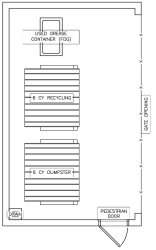3.5.1
Description of Pollutant Sources: The BMPs specified below apply to container(s) located outside a building. Use these BMPs when temporarily storing potential pollution generating materials or wastes. These BMPs do not apply when Ecology has permitted the business to store the wastes (see Volume I, Section 2.15 of the Ecology Manual). Leaks and spills of pollutant materials during handling and storage are the primary sources of pollutants. Oil and grease, acid/alkali pH, biochemical oxygen demand (BOD), chemical oxygen demand (COD) are potential pollutant constituents.
Pollutant Control Approach: Store containers in impervious containment under a roof or in a building. For storage areas on site for fewer than 30 days, consider using a portable temporary secondary system like that shown in Secondary Containment System figure in the Ecology Manual in lieu of a permanent system as described above.
3.5.1.1 Applicable Operational BMPs
-
Place tight-fitting lids on all containers.
-
Label all containers appropriately. Store containers so that the labels are clearly visible.
-
Place drip pans beneath all mounted container taps and at all potential drip and spill locations during filling and unloading of containers.
-
Inspect container storage areas regularly for corrosion, structural failure, spills, leaks, overfills, and failure of piping systems. Check containers daily for leaks/spills. Replace containers and replace and tighten bungs in drums as needed.
-
Store empty drums containing residues to prevent stormwater from entering drum closures. Cover or tilt drums to prevent stormwater from accumulating on the top of empty drums and around drum closures.
-
Store containers that do not contain free liquids in a designated sloped area with the containers elevated or otherwise protected from stormwater run-on. Comply with Title 14 KCC.
-
Secure drums when stored in an area where unauthorized persons may gain access in a manner that prevents accidental spillage, pilferage, or any unauthorized use (see Locking System for Drum Lid figure in the Ecology Manual).
-
If the material is a Dangerous Waste, the business owner must comply with any additional requirements as specified in Volume I, Section 2.15 of the Ecology Manual.
-
Storage of reactive, ignitable, and flammable chemicals or materials must comply with the stricter of Title 14 KCC, Title 17 KCC, the Uniform Fire Code (UFC), UFC standards, or the National Electrical Code.
-
Have spill kits or cleanup materials near container storage areas.
-
Clean up all spills immediately.
-
Cover dumpsters to prevent the entry of stormwater. Keep dumpster lids closed.
-
Replace or repair leaking garbage dumpsters, or install waterproof liners.
-
Drain dumpsters and/or dumpster pads to sanitary sewer.
-
When collection trucks directly pick up roll-containers, ensure a filet is on both sides of the curb to facilitate moving the dumpster.
3.5.1.2 Applicable Structural Source Control BMPs
-
Keep containers with Dangerous Waste, food waste, or other potential pollutant liquids inside a building unless this is impracticable due to site constraints or International Fire Code requirements.
-
Store containers in a designated area, which is covered, bermed or diked, paved and impervious in order to contain leaks and spills (see Figure II-3.1 and Figure II-3.2). The secondary containment shall be sloped to drain into a dead-end sump for the collection of leaks and small spills.
-
For liquid materials, surround the containers with a dike as illustrated in Covered and Bermed Containment Area figure in Volume IV of the Ecology Manual. The dike must be of sufficient height to provide a volume of either 10 percent of the total enclosed container volume or 110 percent of the volume contained in the largest container, whichever is greater.
-
Where material is temporarily stored in drums, a containment system can be used as illustrated, in lieu of the above system (see Secondary Containment System figure in Volume IV of the Ecology Manual).
-
Place containers mounted for direct removal of a liquid chemical for use by employees inside a containment area as described above. Use a drip pan during liquid transfer (see Mounted Container with Drip Pan figure in Volume IV of the Ecology Manual).
Figure II-3.1. Example of a Covered, Bermed, and Plumbed Area – Plan View.
Figure II-3.2. Example of a Covered, Bermed, and Plumbed Area – Side View.
3.5.1.3 Applicable Treatment BMP
This treatment BMP is for contaminated stormwater from drum storage areas.
-
To discharge contaminated stormwater, pump it from a dead-end sump or catchment and dispose of appropriately.

